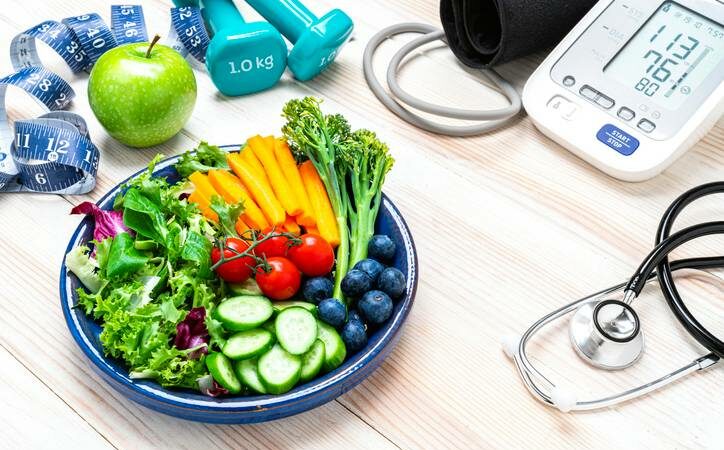Because February is American Heart Month, now is a fantastic opportunity to focus on not only your emotional but also your physical heart health.
Hypertension, or high blood pressure, raises the risk of cardiovascular diseases such as stroke and heart disease. Although hypertension has a genetic component, many of the factors that contribute to high blood pressure can be altered by diet, exercise, and stress management.
Because there are typically no physical symptoms until hypertension has progressed to a more serious condition, it has been dubbed the “silent killer.” It’s critical to see your doctor on a regular basis and have your blood pressure checked so you can have an idea of where it’s at. A blood pressure result of 140/90 mm/Hg is clinically defined as hypertension. If your blood pressure is 130/80 mm/Hg or higher, some clinics will flag you as having pre-hypertension, so keep that in mind as well.
Too much stress is exerted on the walls of your arteries, resulting in high blood pressure. Stress and anxiety, being overweight, a lack of physical activity, and consuming excessive levels of sodium and saturated fat can all contribute to an increase in this force. Fast eats and foods with a high salt content for flavour or preservation can cause your arteries to harden, obstructing blood flow and forcing your heart to work harder to push blood through.
People want supple, elastic veins and arteries, not stiff ones, to allow for consistent blood flow. Saturated fats and cholesterol can be introduced to your system through foods high in saturated fat, such as sweets, tropical oils, and fried foods.
Other risk factors for high blood pressure include having a family history of heart disease, having prediabetes or Type 2 diabetes, or being older. In these instances, it’s also a good idea to keep a closer eye on your blood pressure. If you are at higher risk, checking your blood pressure using an at-home monitor a few times a week and maintaining a journal can be beneficial to your doctor.
Here are some habits you can engage in to help reduce your risk and/or incidence of high blood pressure:
1. Increase your fibre intake:
Fiber can help to lower blood pressure indirectly by reducing the amount of cholesterol, salt, and sugar in your arteries. More cholesterol, salt, and sugar can enter your bloodstream and travel to other regions of your body, including your heart, if you eat enough fibre. Oats, beans, nuts, seeds, sweet potatoes, apples, and berries are all good sources of soluble fibre to include in your diet.
2. Save the salt:
You need salt, or sodium, to keep our electrolyte balance in check. However, many Americans consume too much salt as a result of fast food, highly processed foods, TV dinners, or packaged meals with a lot of added sodium, which helps preserve texture and flavour. Sodium raises blood pressure via a variety of methods. It causes your body to retain more water in an attempt to dilute the salt and wash it out, much like when you shower after a day of swimming in the salty sea.
Sodium also causes vasoconstriction, which causes your arteries to narrow and make blood flow more difficult. When reading food labels, if a food or packaged meal includes more than 300 mg of sodium per serving, most people are likely to consume too much salt in one sitting. Instead, choose potassium-rich fruits and vegetables like bananas.
3. Step up your step count:
You have all got that one friend or family member that is obsessed with their step count. Walking at least 7,000 steps per day has been linked to better cardiovascular health and mortality, but sedentary activity has been shown to have the opposite effect.
Wearable fitness devices, such as Fitbits or smart watches, are great for keeping track of and increasing your daily step count. This does not, however, necessitate the use of a high-tech equipment. Most smartphones come with built-in health apps, or you can use a free step tracking software to achieve the same thing. If you find yourself stuck at your desk all day, consider getting up and moving every 30-60 minutes. This will encourage you to take more steps, get your blood flowing, and benefit your heart and mind.
4. Try to relax:
“You Need to Calm Down,” sings Taylor Swift in one of her pop songs. This is frequently easier said than done, but it is important to remember. Anxiety and stress can flood your system with the fight-or-flight hormones and molecules that get you worked up and elevate your blood pressure if you experience them frequently. Everyone should have good stress coping methods that they may use on a daily basis in any situation. Close your eyes for a few minutes and meditate, then go outside and get some fresh air, listen to your favourite music, or call a friend. Figure out what works best for you.
5. Focus on the type of fat:
One nutrition myth is that dietary cholesterol causes cholesterol to build up in the bloodstream. In actuality, the kind of fat has the greatest impact on blood cholesterol levels. Saturated fat, which can be found in tropical oils, fried dishes, fast food, chicken or turkey skin, and sweet desserts, increases cholesterol levels, which can lead to plaque formation and high blood pressure.
Unsaturated fats, on the other hand, are very protective and help to lower cholesterol levels in the blood. At every meal, try to include one of these preventive fat sources, such as olive or canola oils, avocado, nuts, seeds, or fatty fish like salmon.
6. Vary your workouts:
National standards indicate 75-150 minutes of strenuous physical exercise, 150-300 minutes of moderate physical activity, or a combination of the two. The initial step is to strive toward meeting these goals through exercise and increased movement in general.
Plan planned exercise sessions, such as a 45-minute stroll around the neighbourhood, and add greater movement and intensity into your everyday chores, such as housework or stair climbing. Individuals who do not exercise regularly but add even 10 minutes of action each day to their daily routine can significantly enhance their cardiovascular health, according to research. Once you’ve met the physical activity guidelines on a regular basis, mix up your workouts with a range of activities and intensities. You might pedal the stationary bike one day and then take a new Pilates class the next. This not only keeps you from being bored, but it also challenges your body and heart rate.
If you’re having trouble finding time in your day to focus on or incorporate any of these activities into your daily routine, They recommend blocking off time on your calendar. Approach it like if you were organising a work meeting or your child’s afterschool activities: write it down or type it into your phone’s calendar. It’s straightforward, yet it works.
- Jerry Rice Award History: Every Winner of the FCS Freshman Award - December 13, 2025
- When Do New Episodes of Taylor Swift’s The End of an Era Drop? | Schedule, Dates & Updates - December 13, 2025
- When Does ‘Matlock’ Return? 2026 Premiere Date Guide - December 12, 2025





